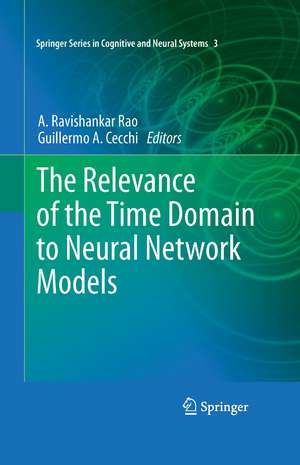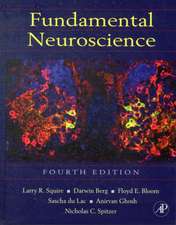The Relevance of the Time Domain to Neural Network Models: Springer Series in Cognitive and Neural Systems
Editat de A. Ravishankar Rao, Guillermo A. Cecchien Limba Engleză Paperback – 27 oct 2013
The purpose of this book is to provide a unified view of how the time domain can be effectively employed in neural network models. A first direction to consider is to deploy oscillators that model temporal firing patterns of a neuron or a group of neurons. There is a growing body of research on the use of oscillatory neural networks, and their ability to synchronize under the right conditions. Such networks of synchronizing elements have been shown to be effective in image processing and segmentation tasks, and also in solving the binding problem, which is of great significance in the field of neuroscience. The oscillatory neural models can be employed at multiple scales of abstraction, ranging from individual neurons, to groups of neurons using Wilson-Cowan modeling techniques and eventually to the behavior of entire brain regions as revealed in oscillations observed in EEG recordings. A second interesting direction to consider is to understand the effect of different neural network topologies on their ability to create the desired synchronization. A third direction of interest is the extraction of temporal signaling patterns from brain imaging data such as EEG and fMRI. Hence this Special Session is of emerging interest in the brain sciences, as imaging techniques are able to resolve sufficient temporal detail to provide an insight into how the time domain is deployed in cognitive function.
The following broad topics will be covered in the book: Synchronization, phase-locking behavior, image processing, image segmentation, temporal pattern analysis, EEG analysis, fMRI analyis, network topology and synchronizability, cortical interactions involving synchronization, and oscillatory neural networks.
This book will benefit readers interested in the topics of computational neuroscience, applying neural network models to understand brain function, extracting temporal information from brain imaging data, and emerging techniques for image segmentation using oscillatory networks
| Toate formatele și edițiile | Preț | Express |
|---|---|---|
| Paperback (1) | 942.01 lei 6-8 săpt. | |
| Springer – 27 oct 2013 | 942.01 lei 6-8 săpt. | |
| Hardback (1) | 942.76 lei 6-8 săpt. | |
| Springer – 15 sep 2011 | 942.76 lei 6-8 săpt. |
Preț: 942.01 lei
Preț vechi: 1148.78 lei
-18% Nou
Puncte Express: 1413
Preț estimativ în valută:
180.28€ • 187.52$ • 148.83£
180.28€ • 187.52$ • 148.83£
Carte tipărită la comandă
Livrare economică 14-28 aprilie
Preluare comenzi: 021 569.72.76
Specificații
ISBN-13: 9781461429920
ISBN-10: 1461429927
Pagini: 244
Ilustrații: XVIII, 226 p.
Dimensiuni: 155 x 235 x 13 mm
Greutate: 0.35 kg
Ediția:2012
Editura: Springer
Colecția Springer
Seria Springer Series in Cognitive and Neural Systems
Locul publicării:New York, NY, United States
ISBN-10: 1461429927
Pagini: 244
Ilustrații: XVIII, 226 p.
Dimensiuni: 155 x 235 x 13 mm
Greutate: 0.35 kg
Ediția:2012
Editura: Springer
Colecția Springer
Seria Springer Series in Cognitive and Neural Systems
Locul publicării:New York, NY, United States
Public țintă
ResearchCuprins
Acknowledgements Foreword.- 1. Introduction.- 2. Adaptation and contraction theory for the synchronization of complex neural networks.- 3. Temporal Coding is not only about Cooperation - it is also about Competition.- 4. Using Non-Oscillatory Dynamics to Disambiguate Simultaneous Patterns.- 5. Functional constraints on network topology via generalized sparse representations.- 6. Evolution of Time in Neural Networks: From the Present to the Past, and Forward to the Future.- 7. Synchronization of Coupled Pulse-Type Hardware Neuron Models for CPG Model.- 8. A Universal Abstract-Time Platform for Real-Time Neural Networks.- 9. Solving Complex Control Tasks via Simple Rule(s): Using Chaotic Dynamics in a Recurrent Neural Network Model.- 10. Time scale analysis of neuronal ensemble data used to feed neural network models.- 11. Simultaneous EEG-fMRI: Integrating Spatial and Temporal Resolution.
Textul de pe ultima copertă
A significant amount of effort in neural modeling is directed towards understanding the representation of external objects in the brain. There is also a rapidly growing interest in modeling the intrinsically-generated activity in the brain, as represented by the default mode network hypothesis, and the emergent behavior that gives rise to critical phenomena such as neural avalanches. Time plays a critical role in these intended modeling domains, from the exquisite discriminations in the mammalian auditory system to the precise timing involved in high-end activities such as competitive sports or professional music performance.
The growth in experimental high-throughput neuroscience techniques has allowed the multi-scale acquisition of neural signals, from individual electrode recordings to whole-brain functional magnetic resonance imaging activity, including the ability to manipulate neural signals with optogenetic approaches. This has created a deluge of experimental data, spanning multiple spatial and temporal scales, and posing the enormous challenge of its interpretation in terms of a predictive theory of brain function. In addition, there has been a massive growth in availability of computational power through parallel computing.
The Relevance of the Time Domain to Neural Network Models aims to develop a unified view of how the time domain can be effectively employed in neural network models. The book proposes that conceptual models of neural interaction are required in order to understand the data being collected. Simultaneously, these proposed models can be used to form hypotheses of neural interaction and system behavior that can be neuroscientifically tested. The book concentrates on a crucial aspect of brain modeling: the nature and functional relevance of temporal interactions in neural systems.
This book will appeal to a wide audience consisting of computer scientists and electrical engineers interested in brain-like computational mechanisms, computer architects exploring the development of high-performance computing systems to support these computations, neuroscientists probing the neural code and signaling mechanisms, mathematicians and physicists interested in modeling complex biological phenomena, and graduate students in all these disciplines who are searching for challenging research questions.
The growth in experimental high-throughput neuroscience techniques has allowed the multi-scale acquisition of neural signals, from individual electrode recordings to whole-brain functional magnetic resonance imaging activity, including the ability to manipulate neural signals with optogenetic approaches. This has created a deluge of experimental data, spanning multiple spatial and temporal scales, and posing the enormous challenge of its interpretation in terms of a predictive theory of brain function. In addition, there has been a massive growth in availability of computational power through parallel computing.
The Relevance of the Time Domain to Neural Network Models aims to develop a unified view of how the time domain can be effectively employed in neural network models. The book proposes that conceptual models of neural interaction are required in order to understand the data being collected. Simultaneously, these proposed models can be used to form hypotheses of neural interaction and system behavior that can be neuroscientifically tested. The book concentrates on a crucial aspect of brain modeling: the nature and functional relevance of temporal interactions in neural systems.
This book will appeal to a wide audience consisting of computer scientists and electrical engineers interested in brain-like computational mechanisms, computer architects exploring the development of high-performance computing systems to support these computations, neuroscientists probing the neural code and signaling mechanisms, mathematicians and physicists interested in modeling complex biological phenomena, and graduate students in all these disciplines who are searching for challenging research questions.
Caracteristici
The book concentrates on a crucial aspect of brain modeling: the nature and functional relevance of temporal interactions in neural systems Develops a unified view of how the time domain can be effectively employed in neural network models Proposes that conceptual models of neural interaction are required in order to understand the data being collected Includes supplementary material: sn.pub/extras























